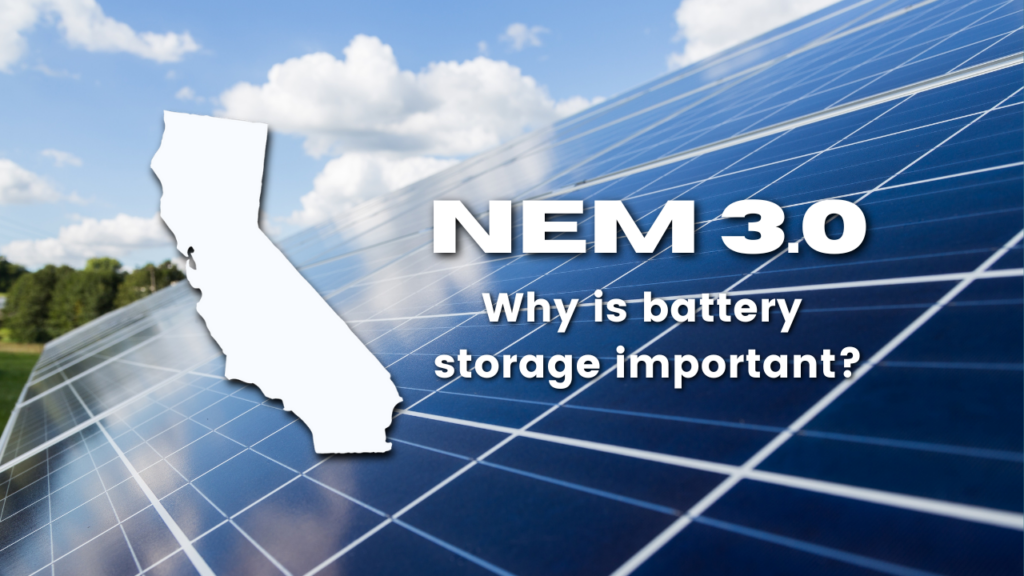The beginning of Net Energy Metering (NEM) 3.0 means major changes in the world of renewable energy and solar batteries for Californians.
The era of NEM 3.0 started on April 14, 2023, when the state of California effectively reduced net metering rates by about 75 percent for new PG&E, SCE, and SDG&E customers.
In this article, we look at some of the ramifications, some background of the road that brought us to NEM 3.0, and how the renewable energy industry may change for Californians – and others – as a result.
What Does NEM 3.0 Mean?
Like any other change in policy, NEM 3.0 took quite a while to reach this stage.
But at the end of 2022, Californians with existing solar setups were informed they had 120 days in which they could be ‘grandfathered’ into the existing NEM 2.0 compensation structure for the next 20 years.
As of April 14, the new NEM 3.0 policy took effect, reducing compensation for excess power sent back to the grid.
A traditional net metering policy offers a credit equal to the ‘going rate’ for electricity for power returned to the grid. In other words, power exported from your system is credited at the same rate as power consumed.
NEM 3.0 changes this policy from net metering to a concept known as net billing. This means reimbursement for power sent to the grid isn’t based on typical electricity rates but calculated separately based on the day of the week, the time of the day, even the month of the year, in which you export that energy. In all, there are almost 600 possible rates of reimbursement!
But rather than go through all of them, we’ll just mention that the average rate of reimbursement is approximately 25 percent of retail energy costs during those same hours.
What does it mean to customers? NEM 2.0 had a solar payback period of between 5-6 years; that number is now closer to a full decade under NEM 3.0. Additionally, over the lifetime of a system customers lose out on approximately 60 percent of savings under NEM 3.0.
History of Net Metering
Abundant sunshine combined with higher cost-of-living and energy rates have always made California a natural fit for the solar market.
So in an effort to reduce the carbon footprint of the state’s 40 million-plus residents, Net Energy Metering (now known as NEM 1.0) allowed these to access energy from renewable sources, while at the same time crediting customers for the energy they returned to the grid.
Once the home was connected to the grid, it was a simple one-for-one equation. Customers received credit for any power returned to the grid.
Example: A family’s system produces 800 kWh per month of energy, but they use 1,200 kWh that month. The family is billed for only that 400-kWh difference of energy consumed from the grid.
Similarly, those who produced an excess received credit for future use. Reversing the numbers from the above example, a family produces 1,200 kWh per month but only consumes 800 kWh. Now that household has a credit equivalent to 400 kWh for future use.
NEM 2.0
While NEM 1.0 was very successful, there was one catch: once the utility companies attained 5% of power demand from solar generation, the program paused and no one else could benefit from NEM policies.
As more and more Californians installed systems, that 5% tariff loomed ever closer. So the state created NEM 2.0.
Scheduled to take effect no later than July 1, 2017, NEM 2.0 certainly bears some resemblance to its predecessor, but there were a few key differences:
Time of Use. Customers switched to time-of-use energy plans, so electricity was charged at different rates based on the time of day.
Generally, the hours between 5-8 p.m. see the highest charges, while the overnight hours come with the lowest charges due to the low number of people using electricity.
Conversely, for net metering customers this meant adding some strategy into when to send their excess power to the grid. Consumers would now attempt to send the maximum amount of electricity back to the grid during those peak hours to maximize credit.
Non-bypassable charges. A small charge in the range of 3 cents per kWh included into energy charges would not be earned when sending power back to the grid. The amount wasn’t important so much as it symbolized that consumers could no longer earn the true ‘retail rate’ when returning energy to the grid.
How Will NEM 3.0 Impact Solar Batteries?
Of course, non-bypassable charges are an easy pill to swallow when compared to the impact of NEM 3.0.
With buyback rates cut by 75 percent, NEM 3.0’s net effect is encouraging the export of stored energy during the peak hours of 4 p.m. to 9 p.m.
A battery storage system allows homeowners to send energy back to the grid during these hours when the grid is working hardest.
During peak sunlight hours, your system powers your home or charges your battery, allowing you to maximize savings by sending excess power back to the grid at the right time (peak hours).
On the other hand, at night you can power your home from the battery or using the grid’s inexpensive nighttime rates, saving stored energy for use or export during peak hours.
It’s easy to focus on the drawbacks of NEM 3.0 from the perspective of slashing credits and extending the payback period. But leveraging batteries will have the desired effect of reducing Californians’ dependence upon the grid during peak periods.
How Should I Send Power Back to the Utility Under NEM 3.0?
The shortest answer is you shouldn’t, except during very specific times.
Based on the differing buyback structures of NEM 3.0, selling back to the utility makes financial sense only between the hours of 5:00 p.m. and 7:00 p.m. during the month of September. Outside of those tiny windows of time, your solar energy is best kept for your own consumption to lessen your own dependence on the grid and the accompanying price hikes.
In a state that saw some 566 power outages in 2022, investing in solar will always make good sense from a practicality standpoint. The financial incentives, however, are changing under NEM 3.0. Pairing a solar system with battery backup will allow each homeowner to minimize the payback period in this new era.









